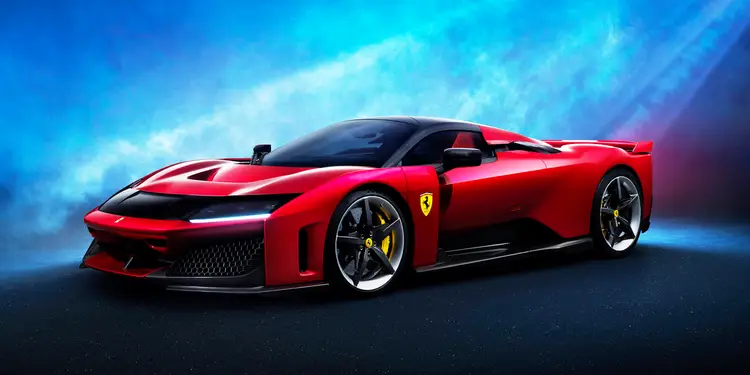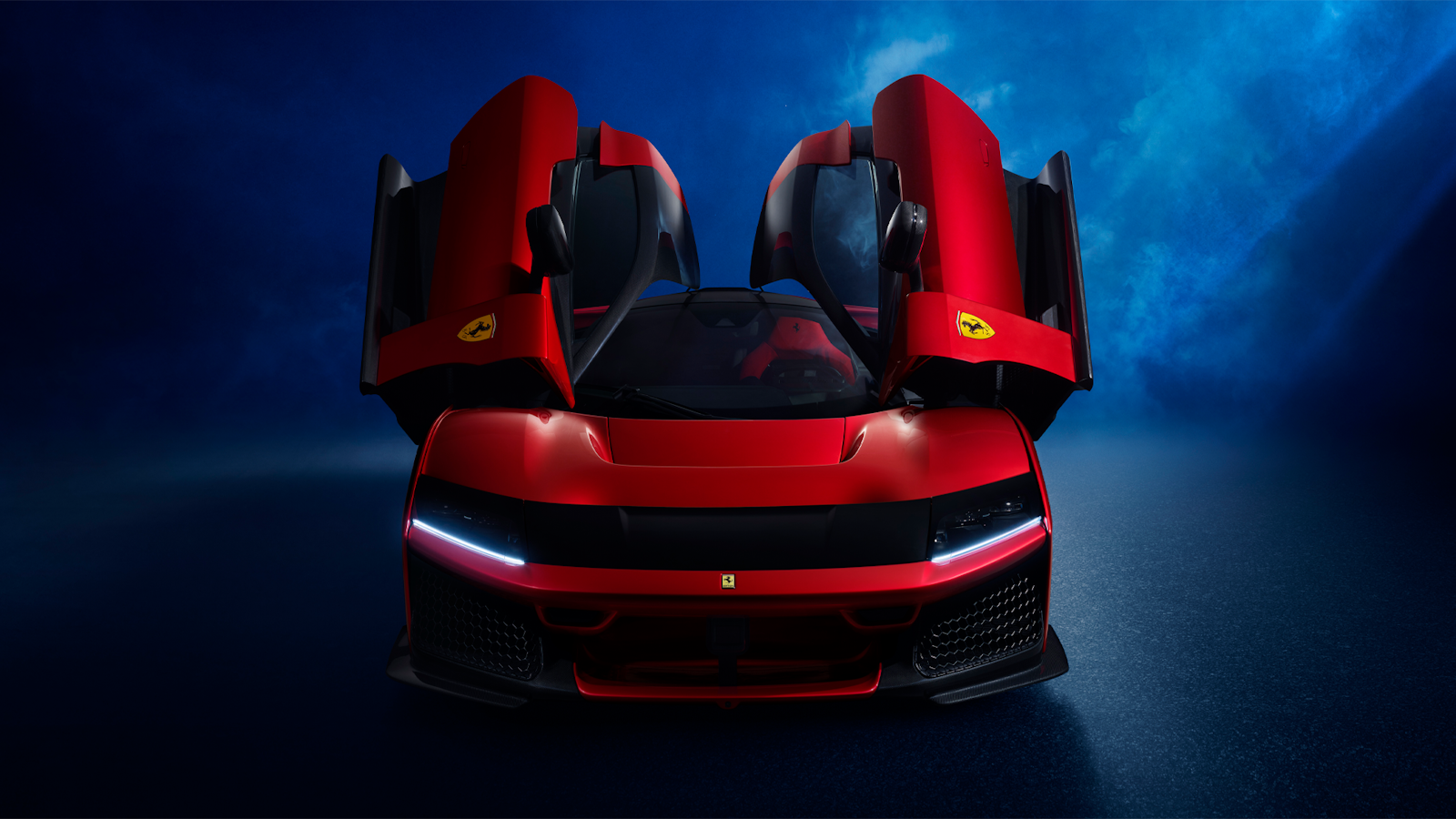New Ferrari F80 revealed: V6-powered LaFerrari successor is the most powerful model ever

Introducing the new Ferrari F80, the eagerly anticipated successor to the LaFerrari. This model is set to compete directly with the McLaren W1 and features a hybrid V6 engine under the hood.

Following closely behind the release of the new McLaren W1, the Ferrari F80 has now been unveiled. This marks the second vehicle in what's referred to as the "holy trinity," which features the top-tier hypercars from McLaren, Ferrari, and Porsche.
The F80's engine has half the number of cylinders compared to the legendary LaFerrari, yet, due to an intelligent hybrid system, it holds the title of the most powerful road car Ferrari has ever produced.
Ferrari F80: Unveiling A Bold New Design
Before diving into discussions about speed and performance, let's first focus on design. After all, a big part of owning a Ferrari is making a statement, so it's essential that the new F80 flagship truly impresses.

It doesn't create the same wow factor as the LaFerrari did when it debuted in the early 2010s, likely because wealthy collectors prefer that this car doesn't outshine their custom-made, unique hypercars like the SP8 Roadster.
The dark strip at the front of the car closely resembles that of the 12 Cilindri GT, and the square-shaped headlights are also reminiscent of that model. However, the front of this car isn't as sharply angled or striking as the LaFerrari or the Enzo that came before it.
The side profile tells a similar tale, showcasing a surprisingly understated design for a hypercar. The roof sits a full five centimeters lower than that of the LaFerrari, and the staggered alloy wheels are quite striking. The front wheels measure 19 inches, while the ones at the back are 20 inches.

The car features an impressive rear wing that adds a dramatic touch, although it doesn't perform the same impressive maneuvers as the McLaren W1, which can extend both backward and upward. Additionally, there's a suggestion of the SP3 Daytona design at the back.
Ferrari F80: Engine Specs And Performance Unveiled
Dedicated Ferrari enthusiasts might be feeling a bit unsettled by this news, as the new F80 marks the first major model from the brand created to honor the company’s anniversary that doesn’t feature a powerful V12 engine.
Actually, it features half the number of cylinders. The latest F80 comes equipped with a 3.0-liter twin-turbo V6 engine, which is a modified version of the engine found in the 296 GTB. But before you grab your pitchforks and head to Maranello, you might want to check out its impressive power output.

This particular V6 engine has already been utilized in the 499P, a hybrid hypercar that has claimed victory in the Le Mans 24-hour race two times. Due to strict racing regulations, the engine in that vehicle is capped at 680 horsepower. However, in this application, there are no restrictions, allowing it to generate 900 horsepower and 850Nm of torque.
That's an additional 100 horsepower compared to what you get with the LaFerrari, and we haven't even discussed the hybrid system yet. The F80 is equipped with a total of five electric motors. Two of these assist in boosting the turbos to achieve 900 horsepower, while one motor drives the rear wheels and the other two power the front wheels.

As a result, this system generates a remarkable 1,200 horsepower, making it the strongest Ferrari road car to date. While it's 75 horsepower shy of the McLaren W1, it boasts a time of just over half a second faster from 0 to 60 mph compared to that vehicle.
It finishes the sprint in a mere 2.15 seconds. This impressive speed is largely due to its all-wheel-drive system, while the McLaren delivers all 1,275 horsepower solely to the rear wheels.
Ferrari F80: New Chassis And Suspension Upgrade
Given the presence of numerous electric motors and batteries, you might assume that this Ferrari would be extremely heavy. Surprisingly, it weighs only 1,525 kg without any fluids, making it 100 kg lighter than the SF90.

How has Ferrari achieved this? First of all, they've created a completely new carbon fiber chassis that is lighter, more rigid, and slimmer than previous models. Additionally, they’ve incorporated 3D printing for the first time to reduce the weight of the front suspension as much as possible.
Nonetheless, the McLaren W1 weighs in at only 1,399kg without fluids, which means the F80 isn't exactly light. Consequently, the W1 boasts an impressive 911hp for each ton, while the F80 offers a more modest 787hp per ton.
The vehicle comes equipped with active shock absorbers, much like those found in the Purosangue SUV. These allow you to change the ride height at each corner using electric motors integrated into the dampers. This feature enables the car to tilt smoothly into turns and prepares the suspension to handle rough patches effectively.

Inside The New Ferrari F80
The cabin features a unique design element due to its new, slimmer carbon chassis. In contrast to the W1, where the seats are stationary, the Ferrari offers an adjustable driver's seat while the passenger seat remains fixed but is positioned to one side and set further back.
This design enables the driver to sit closer to the center of the vehicle, improving their visibility. It resembles the configuration found in the 499P racing car.
The rest of the cabin offers a much more upscale experience compared to a typical endurance racing car, yet it retains several design elements inspired by Le Mans, like the square-shaped steering wheel. Additionally, it includes physical knobs and dials instead of haptic touch controls, making them more practical to operate on the track, especially when you're wearing your Ferrari driving gloves.

New Ferrari F80: What’s The Price Tag?
The answer is quite straightforward: a considerable amount. Ferrari plans to produce only 799 units of this car, with each one priced around £3 million. Remarkably, all of them have already been sold.
This puts it a million pounds above the McLaren W1, which is even rarer with only 399 units produced, all of which are already sold out. If you weren't able to get your hands on these top-tier models, you'll need to hold off until Porsche reveals its new vehicle inspired by the Mission X concept. Alternatively, a convertible Aperta version of the F80 may also be released in a few years.
Ferrari F80 Vs McLaren W1: A Showdown
It's hard not to draw comparisons between the new F80 and the McLaren W1. The two vehicles were unveiled within just a couple of weeks of each other, and both aim to set a new standard for hybrid hypercars in this era.

It’s no surprise that the two cars have nearly identical key statistics, which makes us really eager to see which one would come out on top in a track competition or a drag race.
The F80 generates a bit less power than the W1, featuring a 3.0-liter V6 engine combined with a triple electric motor hybrid system that delivers 1,200 horsepower. In contrast, the McLaren is equipped with a 4.0-liter V8 engine paired with a single electric motor, resulting in a total output of 1,275 horsepower.
The Ferrari takes the lead in the crucial 0-62mph acceleration test, clocking in at just 2.2 seconds compared to the McLaren's stated time of 2.7 seconds. This advantage can be attributed to the Ferrari’s all-wheel drive system, which accounts for the quicker pace. However, both vehicles boast the same times for reaching 0-124mph and share a top speed of 217mph.

The F80 is somewhat heavier than the McLaren, with a dry weight of 1,525kg (not including the driver and fluids), compared to the W1's weight of 1,399kg.
When it comes to cost, expect to spend approximately £2 million if you want a McLaren W1 in your driveway (or safely tucked away in your temperature-controlled garage). The F80 comes with a higher price tag of £3.1 million, but it's also a bit more common, as Ferrari plans to produce 799 F80s. In contrast, the W1 is much rarer, with only 399 units being made.
Are you in search of a simple way to swap your vehicle? If so, Carwow is your solution. You can sell your used car at an excellent price and find the best offers on a new one—all through our reliable network of dealers, without ever leaving your home. Click the button below to begin today.











































